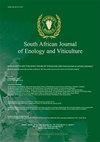“Kishmish Vatkana”(Ren1)和“Villard Blanc”(Ren3和Rpv3)抗病位点的有效性和遗传位置的确认
IF 1.1
4区 农林科学
Q4 FOOD SCIENCE & TECHNOLOGY
引用次数: 3
摘要
本研究旨在验证南非“Kishmish Vatkana”和“Villard Blanc”真菌抗病基因的有效性,并使用微卫星(SSR)标记和定量性状位点(QTL)方法对其进行基因表征。使用F1“Sunred Seedless”דKishmish Vatkana”杂交,为已知携带“Kishmesh Vatkana'”Ren1型白粉菌基因座的13号染色体生成部分连锁图。该基因座的有效性得到了验证,解释了44.8%至57.7%的观察到的表型变异。使用F1‘Villard Blanc’בG1-6604’杂交来生成染色体15和18的部分连锁图,据报道,这两个染色体含有‘Villard Blanc’的真菌抗性基因。在‘Villard Blanc’的15号染色体上验证了白粉病QTL(Ren3),该QTL解释了18.9%-23.9%的表型变异。在‘Villard Blanc’的18号染色体(Rpv3)上的抗霜霉病QTL也得到了证实,它解释了19.1%-21.2%的表型变异。这种分子信息和抗性的个体来源已经在农业研究委员会(ARC)Infruitec Nietvoorbij的食用葡萄育种项目的标记辅助选择(MAS)和基因聚合工作中得到了实施。本文章由计算机程序翻译,如有差异,请以英文原文为准。
Confirmation of the effectiveness and genetic positions of disease resistance loci in ‘Kishmish Vatkana’ (Ren1) and ‘Villard Blanc’ (Ren3 and Rpv3)
This study aimed to validate the effectiveness and to genetically characterise the fungal disease resistance genes of ‘Kishmish Vatkana’ and ‘Villard Blanc’ in South Africa using microsatellite (SSR) markers and a Quantitative Trait Loci (QTL) approach. An F1 ‘Sunred Seedless’ × ‘Kishmish Vatkana’ cross was used to generate a partial linkage map for chromosome 13 known to harbour the Ren1 powdery mildew locus of ‘Kishmish Vatkana’. The effectiveness of this locus was validated, explaining between 44.8% and 57.7% of the observed phenotypic variance. An F1 ‘Villard Blanc’ × ‘G1-6604’ cross was used to generate partial linkage maps for chromosomes 15 and 18, reported to harbour fungal resistance genes of ‘Villard Blanc’. The powdery mildew QTL (Ren3) was validated on chromosome 15 of ‘Villard Blanc’, which explained between 18.9% and 23.9% of the phenotypic variance observed. The downy mildew resistance QTL on chromosome 18 (Rpv3) of ‘Villard Blanc’ was also confirmed, and it explained between 19.1% and 21.2% of the phenotypic variance observed. This molecular information and individual sources of resistance have already been implemented in the marker-assisted selection (MAS) and gene pyramiding efforts of the table grape breeding program of the Agricultural Research Council (ARC) Infruitec-Nietvoorbij.
求助全文
通过发布文献求助,成功后即可免费获取论文全文。
去求助
来源期刊
CiteScore
2.50
自引率
7.70%
发文量
1
审稿时长
>36 weeks
期刊介绍:
The South African Journal of Enology and Viticulture (SAJEV) publishes full-length original Research Papers, Research Notes and Review Papers on all subjects related to enology and viticulture. The SAJEV does not accept articles published in, or submitted to, other journals.

 求助内容:
求助内容: 应助结果提醒方式:
应助结果提醒方式:


